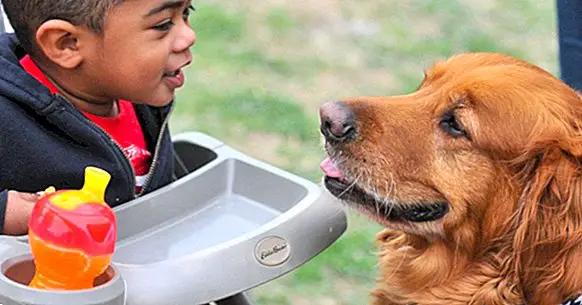Assisted Intervention with Animals: a special therapy
Thousands of years ago, the animals have accompanied the human being in the course of history playing different roles that have facilitated our survival and our well-being.
The domestication put certain species at our service adapting to the needs of the human being, however, the emotional and physical welfare of the animal has not been taken into account. Luckily, in recent years, the process of evolution of the human being has gone hand in hand with awareness, education and respect for animals.
Although it is true that in Spain there is much to do in terms of education and traditions that do not involve animal pain and suffering, we are pleased that there are more and more training initiatives that provide real knowledge about the animal to provide a better life for its animals. ethology The new generations are eager to do well and it seems that empathy with living beings makes its way.
But why introduce our field of work with a paragraph on animal welfare? Because, as psychologists, if we want to focus on working with emotions and human welfare and we want an animal as a facilitator and companion , our tool must be well taken care of and balanced since it is also an emotional being like us.
- Related article: "The benefits of dog therapy"
Animal Assisted Intervention
But, let us start at the beginning: an Assisted Animal Intervention (IAA) is a formula that intentionally includes or incorporates an animal with the aim of promoting improvement in the fields of health, education and social in order to obtain therapeutic benefits in humans.
If, as you read, they are therapies or interventions, although I do not intend to enter into the debate of the typical intrusiveness that psychologists suffer in all our disciplines; IAAs are another focus of malpractice where we find professionals with profiles far from the socio-sanitary-educational field carrying out "Assisted Therapies with Animals".
Being a little regulated area and still with many legal gaps to consider it a psychological and / or therapeutic technique It is true that we are getting more and more welcome in public academic bodies. Since October 2015, thanks to the International University of Andalusia (UNIA) and the University of Jaén, the Official Master in IAA has been launched in order to regulate the profession. In addition, in Madrid, through Rey Juan Carlos University, the need to inculcate and raise awareness of values of respect and care for animals from an early age is being brought closer to all audiences (Chair of Animals and Society - Office of Assisted Interventions with Animals ).
- Related article: "Dolphin Assisted Therapy: acoustic waves that heal"
The origins of this strategy
Focusing on our profession, the introduction of dogs in consultation has its beginnings in the renowned Dr. Sigmund Freud that his dog Jofi supported during his psychotherapy sessions. It was not until 1953 that Dr. Borris Levinson, began to raise the bases of Assisted Therapy with Animals thanks to his dog Jingles, motivating partner and facilitator of the nexus between patient and professional.
With these precursors and within a wide range of experiences and scientific studies, we find how IAAs bring benefits at an integral level: decrease in stress, decrease in blood pressure and heart rate, as well as, decrease in feelings of loneliness and abandonment, increase of social interaction and stable socio-emotional functioning.
- Maybe you're interested: "Sigmund Freud: life and work of the famous psychoanalyst"
The benefits of animal therapies
Although this area usually focuses more on working with children and people with some type of alteration in any of the areas mentioned above, we are all candidates to benefit from what animals provide us .
And what kinds of specific benefits do they give us then? For example, petting an animal helps reduce blood pressure and, therefore, it originates a state of relaxation, while playing or walking with it favors the practice of physical activity, associated with the creation of habits and routines associated with our occupational need. From an emotional point of view, the animal promotes and improves both the communication and social skills and, in turn, enhances positive emotions and self-esteem.
It is important to keep in mind that the effectiveness of an animal treatment does not depend on the animal, the values, knowledge and skills of the psychologist to introduce this technique in the most effective way.It tends to carry a lot of responsibility in the animal and in seeking a polyvalent tool that is adapted to the specific needs of each patient and this is an important bias that we are observing in students and professionals who carry out IAA.
The fundamental role of the animal is to facilitate and motivate, thus providing different stimuli that enrich and complement the interaction between professional and patient. The animal will participate in the sessions within a welfare protocol that takes into account their emotions and above all, their stress. Taking as an example the world of horses and equine therapy , the effort is to leave aside the mount and encourage the work "foot to land" that allows us to know the animal from its ethology and learn about its communication.
- Maybe you're interested: Therapy with horses: an alternative therapeutic resource "
conclusion
Without a doubt, animals can become great teachers who teach us to look deep inside us, they are a mirror, a radar that informs us through their nonverbal language when we are not being clear or coherent.
The reaction of animals helps us to observe ourselves better , to value our use of communication and its effectiveness. They can not be held responsible, if something does not work in our interaction with them the need will be to become aware of what we are asking them and above all, how we are asking for it.
In this way, effectiveness goes through finding the best version to offer to others and even to ourselves. And that is precisely the main objective of assisted interventions with animals: improve the quality of life of patients with the help of those who can take our most natural and emotional side.



















